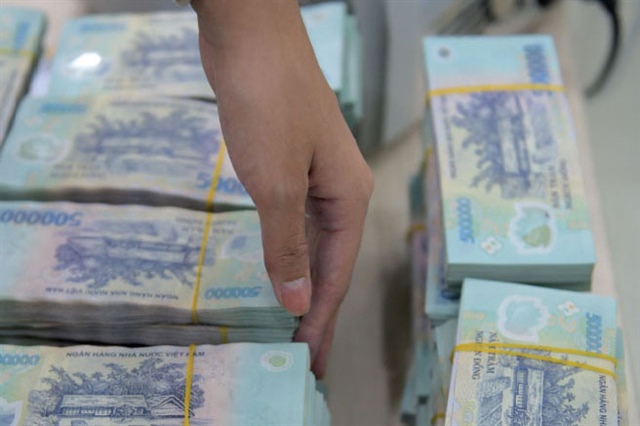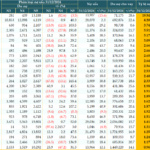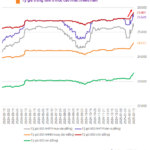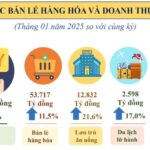
In 2024, an additional 2.1 quadrillion VND was added to the economy’s outstanding debt. Photo: LÊ VŨ |
The correlation between credit and economic growth is evident. On average, a 1% increase in economic growth (GDP) requires more than a 2% increase in credit growth. For instance, in 2023, a GDP growth rate of nearly 7% corresponded to a 14.55% credit growth rate. Similarly, in 2024, a 7.09% GDP growth rate was accompanied by a 15.08% credit growth rate. According to a recent statement by the State Bank of Vietnam (SBV), the credit growth target for 2025 is set at approximately 16% to achieve an economic growth target of 8%. If the economy aims for a 10% growth rate, the credit growth rate would need to be in the range of 18-20%.
As shared by the SBV representative, the total outstanding debt at the end of 2023 was approximately 13.4 quadrillion VND, and it increased to 15.5 quadrillion VND by the end of 2024. This means that in 2024 alone, we added roughly 2.1 quadrillion VND to the economy’s outstanding debt. Throughout 2024, the total lending volume was 23 quadrillion VND, and the debt collection volume was 21 quadrillion VND, resulting in a 7.09% GDP growth rate.
The banking system’s credit activities and the economy’s growth are intricately linked and influence each other. Specifically, expanded credit policies enable businesses to access loans more readily, allowing them to expand their production, invest in new technologies, improve manufacturing processes, and develop infrastructure. These factors contribute to increased labor productivity and job creation, ultimately driving economic growth.
Similarly, households and individuals benefit from easier access to loans for purchasing goods and services or investing in education and housing. As consumer demand rises, businesses respond by increasing production to meet market demands, creating a positive economic cycle that further stimulates the economy.
|
Overreliance on credit policies can pose potential risks to the economy. The credit cycle effect suggests that if credit growth is too rapid or poorly managed, it can lead to risks within the financial system, such as bad debts and asset bubbles. When these risks materialize, the credit cycle can reverse, resulting in economic downturns. |
On the other hand, when the economy experiences positive growth, businesses and individuals become more confident about the economic outlook, leading to increased demand for loans for investment and consumption.
However, the 2:1 ratio between credit growth and economic growth is not set in stone. For instance, in 2022, GDP growth reached 8.02%, while credit growth was slightly above 14%. Similarly, in 2021, GDP growth was 2.58%, while credit growth exceeded 13.6%. In 2020, GDP growth was only 2.91%, yet credit growth was nearly 12.2%.
In reality, during certain periods, high credit growth can be attributed to debt restructuring efforts by the banking system to help businesses overcome economic challenges or meet year-end targets. Additionally, credit flows primarily drive growth in private investment. Therefore, when the growth momentum in the state or foreign-invested enterprise (FIE) sectors weakens, high credit growth may not significantly impact overall economic growth.
For instance, during the 2020-2021 period, the COVID-19 pandemic and prolonged social distancing measures disrupted global trade, negatively affecting the production activities of FIEs. At the same time, public investment projects faced delays, resulting in low economic growth despite the monetary authority’s aggressive monetary easing policies, including interest rate reductions and credit incentives.
Degree of Dependence and Asset Bubble Risks:
Nonetheless, it is undeniable that economic growth has become increasingly reliant on monetary policy, as the effectiveness and reach of fiscal policy have not met expectations. While the disbursement pace of public investment projects has improved compared to previous years, the annual targets have yet to be fully achieved, and many large-scale projects continue to face challenges in land clearance processes.
Consequently, to ensure economic growth, the SBV has pursued a loose monetary policy in recent years, characterized by expanded credit growth targets for banks and consistently low-interest rates to stimulate credit demand. Notably, stable inflation control in Vietnam has facilitated the maintenance of this accommodative monetary policy stance.
However, as previously mentioned, overreliance on credit policies can introduce potential risks to the economy. The credit cycle effect suggests that if credit growth is too rapid or poorly managed, it can lead to risks within the financial system, such as bad debts and asset bubbles. When these risks materialize, the credit cycle can reverse, resulting in economic downturns.
The recent trend of increasing non-performing loans over the past two years reflects this phenomenon, as many businesses have struggled to recover from the impact of the COVID-19 pandemic. According to the published 2024 financial statements, the total on-balance-sheet bad debt of 27 banks exceeded 227 trillion VND, with 24 banks experiencing an increase in bad debt.
According to analysts, after two peak years of the pandemic, many businesses are now feeling the full impact. The figure of 58,300 businesses exiting the market in January 2025, 1.75 times the number of newly established enterprises, with a sharp increase in the number of businesses temporarily suspending operations, is a cause for concern.
Additionally, when businesses are already weakened, injecting more credit into the economy may, in some cases, help them recover, but it can also deepen their difficulties and increase the risk of bad debts. Particularly, if the production sector cannot absorb the abundant credit, this capital may flow into asset investment channels, potentially forming new asset bubbles.
This process can be described as follows: when interest rates are low and credit is easily accessible due to banks’ pressure to disburse funds, investors tend to leverage this cheap capital to purchase assets such as securities and real estate, expecting quick profits. The abundance of credit continues to drive up asset prices, leading to attractive returns, which further fuels expectations of price increases and encourages speculative investments.
When asset prices have risen too high and are no longer supported by economic fundamentals, the market may enter a phase of significant correction. Especially if negative factors such as rising interest rates or tightening credit supply come into play, capital may flow in the opposite direction, causing a sudden drop in asset prices. This price decline can trigger bad debt issues, especially for investors who have used high leverage.
Tuệ Nhiên
– 10:00 14/02/2025
How to Prevent Bad Debt from Becoming an Economic Hindrance?
The rising tide of non-performing loans is a significant challenge for Vietnam’s banking system. It is not merely about managing bad debt but also about building a foundation for businesses to thrive and grow in an ever-changing world, ensuring that non-performing loans do not hinder the development of the financial system.
“A Call for Doubling Down on Efforts: Aiming for 8% and Beyond”
Achieving a growth rate of 8% or higher in 2025 will pave the way for even higher growth rates in the following years, with aspirations to reach double digits, surpassing 10%. However, to attain this new growth target, it is imperative that all ministries, sectors, and local authorities demonstrate an even stronger resolve, doubling their efforts from previous years.
Unleashing the Power of Words: Crafting Captivating Copy for a Vibrant City
Unveiling the Economic Pulse of Ho Chi Minh City: Positive Growth with Retail Leading the Charge
The Ho Chi Minh City economy in January 2025 witnessed positive growth, especially in retail and consumer services, with revenue reaching nearly VND 108,000 billion. Moving forward, the city will continue to focus on key tasks, accelerate public investment disbursement, and promote administrative reform.
What Solutions Will Drive Ho Chi Minh City’s Double-Digit Growth?
According to Ho Chi Minh City Party Committee Secretary Nguyen Van Nen, the city must achieve the target of double-digit growth and fulfill all 22 set indicators. This is an ambitious goal, but with the right conditions and a dedicated effort, it can be achieved.





















